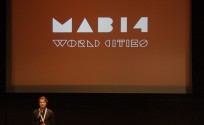Awards: Categories and Criteria
The jury is made up of memebers of the Biennale Organising Committee and a number of invited experts:
- Alexander Wiethoff (University of Munich)
- Ava Fatah (The Bartlett, UCL)
- Gernot Tscherteu (Media Architecture Institute)
- Juan C. Carvajal (Media Architecture Institute)
- Marcus Foth (Queensland University of Technology)
- Martin Brynskov (Aarhus University)
- Matthew Claudel (Senseable Lab, MIT)
- Susa Pop (Public Art Lab)
Criteria
The jury evaluates the projects according to the following criteria:
- Aesthetic qualities
- Innovative elements
- Technical challenges mastered
- Integration of different project components e.g. architecture, display and content
Award Categories
- Animated Architecture: Projects demonstrating creative media facades solutions. Fa- cades of buildings are increasingly animated by integrated light sources. Designers are focusing more and more on the perception of the building. The flexibility of content is rather limited due to resolution, colour and shape of the pixels. In most cases the pixels are highly customised and present a creative challenge to the project.
- Money Architecture: Projects incorporating buildings that are closely related to business, banks, shopping centres, entertainment and gambling. Lighting on building surfaces might be designed to attract people and encourage spending, or to represent the power of the institution, as in the case of banks for example.
- Participatory Architecture and Urban Interaction: The last Biennale showed that there are plenty of opportunities to contribute to local city development from a bottom up perspective. As this year‘s Biennale topic is “World Cities” we are specifically looking for projects that support the development of sustainable social structures with urban digital media or media architecture. It does not matter whether projects are made in an artistic or civic society or any other context – innovation and the impact on the city is essential.
- Spatial Media Art: Projects produced in an artistic context at the intersection of archi- tecture and media art. Mostly non-permanent movable installations with an innovative form of spatial interaction and/or perception of space.
- Future Trends and Prototypes: This sections covers special solutions like three-dimen- sional displays, kinetic facades, OLEDs or even robotic elements that could shed light on what future media architectures might look like.
All projects are built or realised, except if they fit the category “Future Trends and Prototypes”.



































